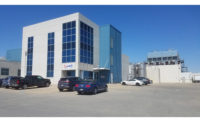The first thing most visitors see as they draw near to the fresh cheese plant operated by Crave Brothers Farmstead Cheese LLC is a colorful, hand-painted 52-square-foot mural depicting the unique farm-to-consumer journey of the family-run company’s products. Back in 2018, Rosemont, Ill.-based Dairy Management Inc. selected the Waterloo, Wis., farmstead cheese plant as one of only seven locations across the nation to get such a mural.
The mural is front and center on the newest addition to the 40,000-square-foot cheesemaking facility, which was completed in 2017. Crave Brothers Farmstead Cheese says the mural captures the story of the environmentally conscious Crave family and the family values that drive its business. The operation the mural depicts is truly farmstead, encompassing an on-site farm with sustainable feed-crop farming practices and 2,000 or so “pampered” dairy cows, a handcrafted cheesemaking process that starts with hours-old fresh milk, and expedient transport to customers — and, ultimately, consumers.
To further boost the sustainability quotient, the cheese plant is powered by a computer-controlled anaerobic methane digestion system on the company’s on-site farm. That system also generates enough electricity to power the farm and 300 area homes.
The road to quality cheese
Inside the plant, approximately four dozen employees make fresh cheeses, including fresh mozzarella, sweet cream mascarpone, Oaxaca cheese, string cheese (Farmer’s Rope) and fresh cheddar cheese curds in several varieties, explains Debbie Crave, vice president of Crave Brothers Farmstead Cheese.
Many of those cheeses have won awards over the years, she notes. For example, the marinated fresh mozzarella took first place in the Flavored Cheese Category at the 2018 World Cheese Championships. And the chocolate mascarpone received the same high honors at the 2019 American Cheese Society competition.
“We’re all about family, the farmstead and green energy,” Debbie Crave says. “But in the end, you still have to have quality cheese. We are happy to win awards that verify our quality.”
Kurt Premo, a licensed cheesemaker with a cheese plant background, is the facility’s production manager, notes George Crave, president and a founding owner of Crave Brothers Farmstead Cheese (as well as husband to Debbie Crave). Beth Crave, George and Debbie Crave’s niece, is director of quality assurance, and Brian Crave, their son, is also a licensed cheesemaker who works in the plant.
Cheese production begins when fresh milk is pumped via underground piping from the family farm to the plant around midnight, notes George Crave. The milk, approximately three and a half tanker trucks’ worth, is super fresh — collected from the company’s herd of cows within the previous 24 hours. It is then pasteurized and transferred to three double-o cheese vats.
During Dairy Foods’ visit, the facility was producing fresh mozzarella balls. In the vats, the product is acidified and set, and then is conveyed to a drain table, George Crave says. Here, the whey is drained off prior to cooking.
The remaining curds are then cooked/stretched/molded into balls and packaged immediately via form-fill-seal equipment. Finished packaged products enter a cold bath before employees box them up by hand. Boxed products are then refrigerated before they are picked up for distribution.
The entire process — completed in just six hours or so — underscores the “fresh” attribute of the cheese.
“We process the milk and mold the cheese all at a pace that we can actually package it,” George Crave points out. “So that’s what’s unique — it’s milk at midnight, and the early cheese is in a package and in the cooler by 6:30 in the morning. That’s very unique in comparison to the way other cheeses are made.”
Adjusting for growth
Over its roughly 20 years of operation, Crave Brothers Farmstead Cheese has seen demand for its cheeses increase significantly. As a result, the company found itself needing more production space — and more bells and whistles — at several points in time. So the 2017 expansion was not the facility’s first — it underwent two prior expansions, in 2005 and 2008.
The plant’s employees now make cheese five days a week — six days during seasonal demand spikes — across overlapping shifts that begin at midnight and end at approximately 6 p.m., George Crave notes. Today’s SQF Level 2-certified plant is set up to allow the production of as many as four different types of cheese at the same time.
New technology also has helped the facility keep up with demand. For example, the plant installed a high-capacity, high-efficiency boiler last year to help boost mozzarella-cooking capabilities. In addition, it put in a new form-fill-seal machine about a year and a half ago, George Crave says, as well as new box formers and other packaging-area additions. The installations helped the company meet increased demand at the retail level associated with the COVID-19 pandemic.
The adjustments for continuing growth will not end with those upgrades. For example, Crave Brothers Farmstead Cheese is hoping to add more mozzarella cookers and molds in the near future — as it anticipates steady growth ahead.
“Like any business, you crawl, you walk, and then you start jogging and then you run,” George Crave says. “Now we’re running at a very comfortable pace. I’m very proud of how efficiently we run and the terrific team we have.”
The company also is investing in practices that not only boost sustainability, but also slash operating costs. For example, as the old lighting in the plant “wears out and gets dim,” it is replacing that lighting with high-efficiency alternatives, George Crave says. And thermostats within the plant are adjusted for energy-efficiency.
What’s more, to prevent the drained whey from becoming a waste product, the plant installed an ultrafiltration (UF) system, he adds. It uses the system to make whey protein concentrate for commercial sale. The remaining permeate gets a home, too.
“The whey permeate is directly pipelined right from the UF machine back underground 500 feet up to the farm, where it goes into the cow feed or into the digester for it to make more electricity,” George Crave explains.
Training is critical
Crave Brothers Farmstead Cheese understands that its unique cheese operations require a thoroughly trained staff. To assist in ongoing efforts here, the company relies on the skills of an energetic trainer who comes to the plant once a week, Debbie Crave says. The trainer is bilingual (English and Spanish) because English is not the first language for many of the plant’s employees.
“She helps us with training, videos — and helps people understand the importance of knowing each process,” she notes. “Because it’s not just cooking cheese and making a square and putting it on the shelf.”
To keep employees “fresh,” the plant does not limit them to one particular task or line, Debbie Crave adds.
“So they have to know a lot of things,” she says. “And they have to care enough to ask a question if they don’t get it, or someone has to point something out. So we need a lot of leaders, line leaders.”
Those leaders often are developed from within. When the company recognizes leadership potential in a particular employee, it encourages him or her to do more, Debbie Crave points out. That scenario recently played out with two plant employees — both native Spanish speakers — who were willing to learn English and much more.
“We put them in a position, gave the training, helped them understand what we expected,” she notes. “And one is leading shipping and one is our quality assurance assistant. … It’s an investment on our part, and yet you know that some people can do more — they care more.”
Safety’s a priority
Food and employee safety are, of course, critical to Crave Brothers Farmstead Cheese’s plant operations, too. On the food safety side, production employees also are charged with cleaning equipment across the overlapping shifts.
“It’s part of the tasks for people who are already here, who are running the cookers or running the pasteurizer, the CIP system,” George Crave points out. “People who come in throughout the day will be in charge of cleaning up — the last shift of packaging people, they’re in charge of cleaning up the packaging area.”
To ensure the effectiveness of cleaning efforts, the plant performs frequent testing and environmental swabbing. It accomplishes some of the testing in-house, while it sends other samples out to a third party. The plant also tests product throughout the day to ensure safety and quality, George Crave says.
“We have a very robust quality assurance process,” he notes.
Because the equipment within the plant has a “limited number of moving parts,” ensuring the safety of employees is a bit easier, perhaps, than in some other cheesemaking facilities. Nevertheless, the company trains employees thoroughly on equipment safety (for example, keeping shields in place) and relies on training videos for chemical handling, George Crave says.
“We even have some of our own videos that we’ve made on how machines should work or how they should look when they’re set up,” he adds.
The COVID-19 pandemic, however, prompted Crave Brothers Farmstead Cheese (like many other food processors) to augment its already-strong employee safety program. Employees are required not only to wear masks, but also to take their own temperatures and record them before starting work on the plant floor. What’s more, the plant is disinfected with an ozone treatment each night.
Preparing for the future
In addition to new safety procedures, the pandemic also brought with it a sharp rise in retail business for Crave Brothers Farmstead Cheese. And plant employees have been stepping up to meet that increased demand.
“We’re really proud to be frontline workers and meet all orders and be very responsive to customers,” Debbie Crave says. “People had to show up to work last March and April, when everyone was scared, at the farm and the cheese factory. … We’re thankful they came because we had milk that we needed to make into cheese, and we had cows that needed to be fed and milked, and we had corn that we needed to plant so the cows could eat.”
Looking ahead, post-pandemic, the company expects to see strong growth in the next four or five years. That growth — an increase of 20% to 25% in volume, George Crave estimates — will require stepped-up production within the cheese plant. To get there, the plant needs to ensure it “has no weak links,” he says.
“I have a sign that says, ‘If one person fails, we all fail,’ which means if there’s a weak link in the chain, everyone else can be doing their job, but we still don’t have the quality product we want,” George Crave notes. “There are more goals to be achieved and more processes to be put into place. But everyone has to be trained and know what their job is.”
Photos by Vito Palmisano











